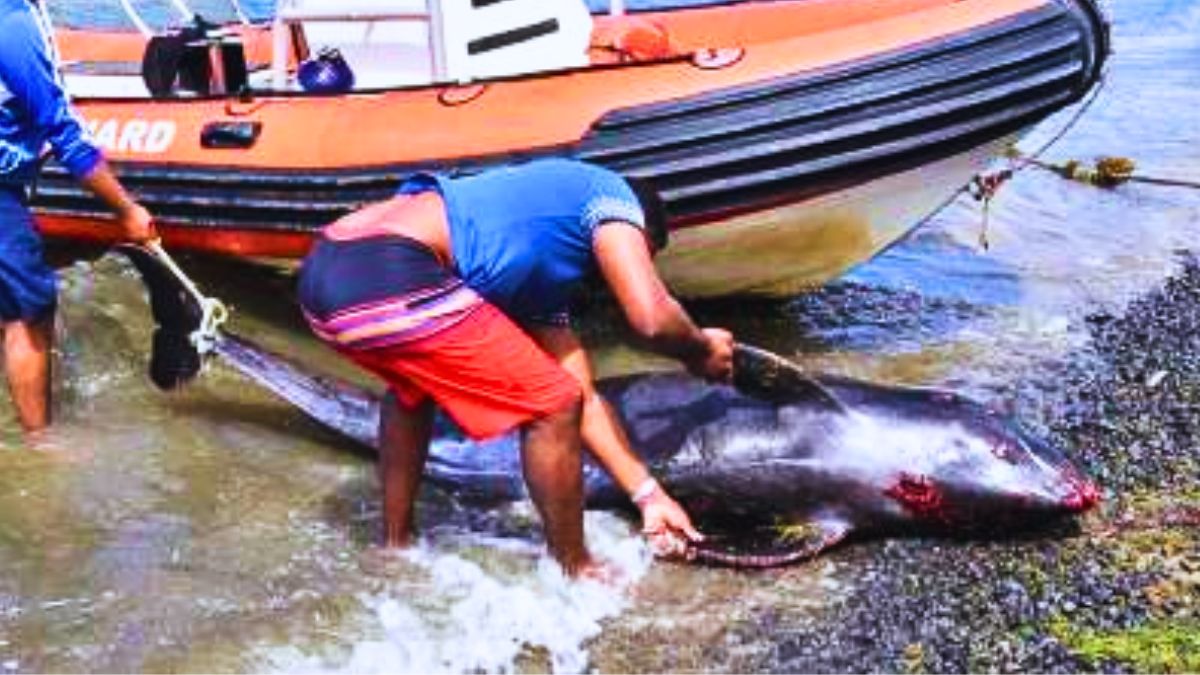News
50 Whales, 2 Dolphins: Brutal Disorientation Revealed in Wakashio Inquiry

A devastating report has shed light on one of the most tragic episodes of the MV Wakashio ecological catastrophe, five years after the bulk carrier ran aground off Pointe-d’Esny in July 2020. The Court of Investigation findings, made public on October 2nd, reveal that the deaths of approximately 50 melon-headed whales and two dolphins in late August 2020 were likely caused by a “brutal disorientation” event, not solely the oil spill.
The report details how more than 150 stressed dolphins of this oceanic species were reported in the Bambous-Virieux lagoon on August 26, 2020.
Despite a major acoustic ‘herding’ operation—involving the coast guard, fishermen, boaters, and NGOs—that managed to guide around 100 animals back to the ocean, about 50 remained disoriented and perished in the lagoon, with some washing up on Bambous-Virieux beach.
Disorientation and Barotrauma
Post-mortem examinations (necropsies) indicated that the animals suffered from barotrauma, similar to decompression sickness.
Veterinarians found petechial haemorrhages in the head and gas emboli (bubbles) in the blood vessels, injuries typical of a rapid ascent from deep water.
They concluded that the dolphins’ deaths were caused by this sudden disorientation, though aliphatic hydrocarbons (present in fuels) were found in some tissues.
The report explores the role of underwater human activity near the wreck. While no chemical toxins were identified as the cause of death, the court investigated whether a multibeam sonar survey, conducted on August 22, 2020, by the Mauritius Hydrographic Office at the ship owner’s request, may have been a trigger.
Although one expert discounted the sonar’s impact based on the frequency, the court concluded that the three-to-four-day gap between this survey and the mass stranding “corresponds more” to the tragedy’s timeline than an earlier survey.
Toxic Contamination and Bioaccumulation Risk
Separately, the report highlights the wider, slow-burn toxic impact of the over 1,000 tonnes of hydrocarbons spilled into the environment.
Environmental engineer and oceanographer Vassen Kauppay-muthoo stated that traces of hydrocarbons were detected on several dolphin carcasses, suggesting exposure through the skin or inhalation of oil slick vapours, though he noted other scientific bodies had diverging conclusions.
More critically, analyses from August 7, 2020, revealed alarming levels of arsenic and cadmium in fish and squid samples, exceeding recommended thresholds.
Hydrocarbon levels were also “particularly high”, demonstrating that the oil had permeated the marine food chain, infiltrating benthic organisms like molluscs and marine worms.
This contamination has caused bioaccumulation, where toxins slowly build up in tissues. Mr. Kauppaymuthoo warned this constitutes a “progressive form of poisoning,” and advised that fishermen collecting mussels and oysters in the mangroves are most exposed to the long-term risk.
Consequently, the report recommends an immediate one-year fishing ban in the area to fully assess the contamination level and safeguard human health.
Command Failures and Decades of Toxicity
The court also cited “human failures and technical shortcomings” that exacerbated the disaster’s scale, pointing to flaws in the chain of command during the initial management of the wreck.
The findings are a stark warning for the future, noting that oil trapped in the seabed sediment will remain toxic “for decades”, underscoring the urgent need to strengthen environmental surveillance and rapid maritime response capabilities.
Source: l’Express











